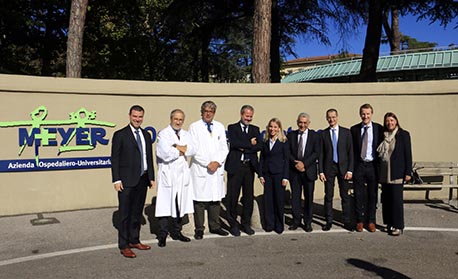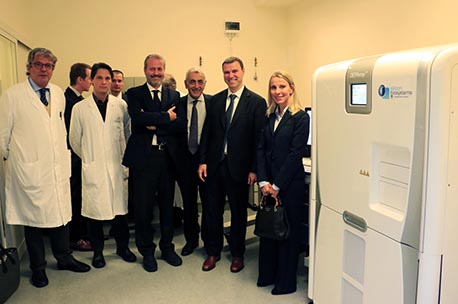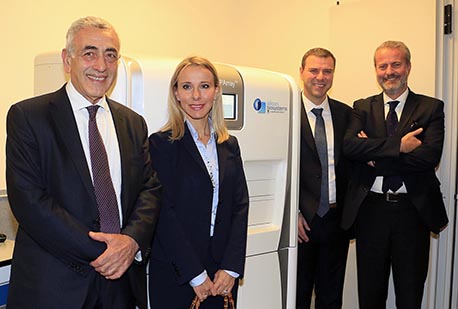Menarini and Meyer, United In The Search For Rare Cells
 |
| |
Florence, 20th october, 2015 – Today marks the day on which the Pharmaceutical Group, A. Menarini I.F.R. , donated an innovative instrument to Florence’s Childrens’ Hospital Meyer. This system, the DEPArray™ System, will allow two of the hospital’s departments to carry out cutting edge research work. The two departments involved are pediatric oncology, headed by Claudio Favre, and neuroscience, guided by Renzo Guerrini. Each of their respective teams will be able to use this precious instrument to select and recover pure single cells, isolating them in several sample types such as blood, bone marrow, pleural fluid, and solid tissue biopsy.
The installation of the DEPArray™ System has opened up a new era in pediatric oncology and neurological research on epilepsy at Meyer. This instrument is unique and precise and allows research teams to reveal even the most secret genetic mechanisms that lie within tumour cells, paving the way towards increasingly more personalised therapies, which are by their very nature, more effective.
The installation of the DEPArray™ System at the Meyer Childrens’ hospital will allow researchers to carry out in-depth studies on both circulating tumour cells and pediatric solid tumours for a greater knowledge of the genetics of cancer.
The DEPArray™ patent belongs to Silicon Biosystems, a Menarini Group company. The DEPArray™ System is the first system capable of automatically isolating single, rare cells suspended in a number of different sample fluids. For example, circulating tumour cells, which can be found in blood samples, can be isolated and maintained intact, live and reproducible for genetic analysis. The system is extremely precise in selecting cells and is capable of selecting even single cells, allowing 100% pure cell preparations.
“Thanks to the DEPArray™ System, we can isolate and select even very small quantities of pure circulating tumour cells,” explained Claudio Favre. “Cells that can provide us with important information such as markers for the evaluation and possible development of metastatic disease. In addition to this we can also gain a better understanding of the biological nature and the level of aggressiveness of the tumour as well as being able to draw up a molecular profile for each individual patient so as to be in a position to devise a personalised course of therapy better aimed at attacking the target cells.”
Another field of research in which this system can be applied is the study of the role played by the immune system in the post-transplant stage through an analysis of biopsy tissues of the intestine. Favre added, “Our objective is to single out potential biological markers capable of foreseeing the onset of a dysregulation of the immune system or its degree of impairment so as to control the course of the disease.”
In the Department of Neuroscience, the DEPArray™ System will be used for studies carried out on epilepsy. “We shall be using this innovative system to extract DNA from cells which have been isolated within a number of different tissue samples, and particularly from brain cells taken from subjects who have undergone neurosurgery to treat their epilepsy,” Renzo Guerrini explained “We intend to study the genetic mutations responsible for the changes in the morphological and functional characteristics of the neurons which are the reasons behind epilepsy.”
Research carried out by a number of different study groups around the world, including the team from Meyer, appears to corroborate more and more the theory that epilepsy, and a number of other brain malformations, often originate from genetic alterations found in a limited number of brain cells. This phenomenon, called ‘mosaicism’, can only be investigated if you have direct access to the cells and subsequently carry out high resolution sequencing studies on the DNA found therein.

Alberto Giovanni Aleotti, Renzo Guerrini, Claudio Favre,
Alberto Zanobini, Lucia Aleotti, Domenico Simone, Gianni Medoro,
Nicolò Manaresi and Barbara Baggiani at the entrance of Florence’s Childrens’ Hospital Meyer
Alberto Zanobini, Director General of the Meyer Children’s Hospital in Florence, Italy: “Thanks to the donation made in favour of the Meyer Children’s hospital by the Menarini Group, our hospital may now widen its horizons and open up new frontiers in the scientific research of the mechanisms behind epilepsy and those responsible for the onset of tumours. Through this project we have forged a meaningful co-operation between an esteemed Italian company and our pediatric hospital, adopting world class technology of the highest level.”
Lucia Aleotti, President of The Menarini Group: “We are here today to donate to the city’s pediatric hospital Meyer, exemplar of Italian excellence amongst children’s hospitals, a system which is built upon a technology of great promise, born out of the research of two Italian engineers who united the potential of electronic engineering with biology to create a digital system for the management of human cells. The DEPArray™ System has been installed in top level research centres in Europe, in the USA and Japan, and to be able to confer one of our systems into the expert hands of the researchers at Meyer is a source of great pride for us. This technology is capable of providing clear results in the genetic analyses of complex tumour tissue samples in the young patients at Meyer. In fact, DEPArray™ allows researchers to get an increasingly better understanding of the genetics that lie behind tumour cells by providing them with results which are precise even in those cases where conventional methods fail due to a poor cancer cell population in the blood sample, a sample which is too small to analyse or the tumour cells in the biopsy tissue are simply not enough.”

Researchers at Meyer in the laboratory where the DEPArray System has been installed with Alberto Zanobini and the management of Menarini

Domenico Simone, Lucia Aleotti, Alberto Giovanni Aleotti and Alberto Zanobini
in the laboratory at Meyer where the DEPArray System will be used
for research in pediatric oncology and neurology























